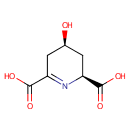|
Record Information |
|---|
| Version |
1.0 |
|---|
| Update Date |
1/22/2018 11:54:54 AM |
|---|
|
Metabolite ID | PAMDB004261 |
|---|
|
Identification |
|---|
| Name: |
(2S,4S)-4-Hydroxy-2,3,4,5-tetrahydrodipicolinate |
|---|
| Description: | The dicarboxylic acid dianion formed from (2S,4S)-4-hydroxy-2,3,4,5-tetrahydrodipicolinic acid by proton loss from both carboxy groups; major species present at pH 7.3 |
|---|
|
Structure |
|
|---|
| Synonyms: | - (2S,4S)-4-Hydroxy-2,3,4,5-tetrahydrodipicolinate
- (2S,4S)-4-Hydroxy-2,3,4,5-tetrahydrodipicolinic acid
- (4S)-4-Hydroxy-2,3,4,5-tetrahydro-(2S)-dipicolinate
- (4S)-4-Hydroxy-2,3,4,5-tetrahydro-(2S)-dipicolinic acid
|
|---|
|
Chemical Formula: |
C7H7NO5 |
|---|
| Average Molecular Weight: |
185.136 |
|---|
| Monoisotopic Molecular
Weight: |
185.033519489 |
|---|
| InChI Key: |
DVTPRYHENFBCII-UHFFFAOYSA-L |
|---|
| InChI: | InChI=1S/C7H9NO5/c9-3-1-4(6(10)11)8-5(2-3)7(12)13/h3-4,9H,1-2H2,(H,10,11)(H,12,13)/p-2 |
|---|
| CAS
number: |
Not Available |
|---|
| IUPAC Name: | (2S,4S)-4-hydroxy-2,3,4,5-tetrahydropyridine-2,6-dicarboxylic acid |
|---|
|
Traditional IUPAC Name: |
(2S,4S)-4-hydroxy-2,3,4,5-tetrahydropyridine-2,6-dicarboxylic acid |
|---|
| SMILES: | OC1CC(N=C(C1)C([O-])=O)C([O-])=O |
|---|
|
Chemical Taxonomy |
|---|
|
Taxonomy Description | This compound belongs to the class of organic compounds known as alpha amino acids and derivatives. These are amino acids in which the amino group is attached to the carbon atom immediately adjacent to the carboxylate group (alpha carbon), or a derivative thereof. |
|---|
|
Kingdom |
Organic compounds |
|---|
| Super Class | Organic acids and derivatives |
|---|
|
Class |
Carboxylic acids and derivatives |
|---|
| Sub Class | Amino acids, peptides, and analogues |
|---|
|
Direct Parent |
Alpha amino acids and derivatives |
|---|
| Alternative Parents |
|
|---|
| Substituents |
- Alpha-amino acid or derivatives
- Tetrahydropyridine
- Dicarboxylic acid or derivatives
- Hydropyridine
- Ketimine
- Secondary alcohol
- Carboxylic acid
- Azacycle
- Organoheterocyclic compound
- Organic 1,3-dipolar compound
- Propargyl-type 1,3-dipolar organic compound
- Imine
- Hydrocarbon derivative
- Organic oxide
- Organonitrogen compound
- Organooxygen compound
- Carbonyl group
- Alcohol
- Aliphatic heteromonocyclic compound
|
|---|
| Molecular Framework |
Aliphatic heteromonocyclic compounds |
|---|
| External Descriptors |
|
|---|
|
Physical Properties |
|---|
| State: |
Not Available |
|---|
| Charge: | -2 |
|---|
|
Melting point: |
Not Available |
|---|
| Experimental Properties: |
|
|---|
| Predicted Properties |
|
|---|
|
Biological Properties |
|---|
| Cellular Locations: |
Cytoplasm |
|---|
| Reactions: | Tetrahydrodipicolinate + NAD + NADP + Water <> (2S,4S)-4-Hydroxy-2,3,4,5-tetrahydrodipicolinate + NADH + NADPH + Hydrogen ionPyruvic acid + L-Aspartate-semialdehyde <> (2S,4S)-4-Hydroxy-2,3,4,5-tetrahydrodipicolinate + WaterL-Aspartate-semialdehyde + Pyruvic acid > Hydrogen ion + Water + (2S,4S)-4-hydroxy-2,3,4,5-tetrahydrodipicolinate + (2S,4S)-4-Hydroxy-2,3,4,5-tetrahydrodipicolinate(2S,4S)-4-hydroxy-2,3,4,5-tetrahydrodipicolinate + Hydrogen ion + NADPH + (2S,4S)-4-Hydroxy-2,3,4,5-tetrahydrodipicolinate + NADPH > Water + NADP + (S)-2,3,4,5-tetrahydrodipicolinate |
|---|
|
Pathways: |
|
|---|
|
Spectra |
|---|
| Spectra: |
|
|---|
|
References |
|---|
| References: |
Not Available |
|---|
| Synthesis Reference: |
Not Available |
|---|
| Material Safety Data Sheet (MSDS) |
Not Available |
|---|
|
Links |
|---|
| External Links: |
| Resource | Link |
|---|
| CHEBI ID | 67205 | | HMDB ID | Not Available | | Pubchem Compound ID | 53323638 | | Kegg ID | C20258 | | ChemSpider ID | 26386323 | | Wikipedia ID | Not Available | | BioCyc ID | Not Available |
|
|---|


